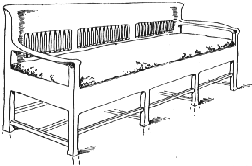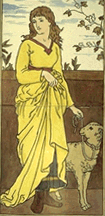

An anthology of writings on interior design by William Morris and his contemporaries, with information about the early years of the Arts & Crafts Movement in England and America.
Selected Links on Related Themes:
 During
the 1870's, American Anglophiles became acquainted with the Arts
& Crafts Movement, first introduced through interest in the
Gothic Revival and the paintings and writings of the Pre-Raphaelite
Brotherhood. The art and architectural criticism of Ruskin, which
laid the foundation of the movement, and lectures on decorative arts
of William Morris were available at the Boston Athenaeum and other
American libraries as soon as they were published in London. Morris
& Company began to sell their wallpapers in Boston in 1873, and
by the mid 1870s had representatives for their growing line of
wallpaper, fabric and carpet in many major American cities. Inspired
by English work, Arts & Crafts artisans and workshop groups
around America began producing their own designs by end of the
1870's, with especially strong centers of activity in Boston and
Cincinnati. The Arts & Crafts Movement also shaped American
architecture, especially with the development of the Queen Anne
Revival, and with emerging styles that were based on the
"old-fashioned homes" of the American Colonial period: the Shingle
Style and the Old Colony Style. The first generation of Arts &
Crafts artisans employed a diverse expression of styles, which drew
inspiration from England, but also from Japan and from the regional
traditional crafts and architecture of America.
During
the 1870's, American Anglophiles became acquainted with the Arts
& Crafts Movement, first introduced through interest in the
Gothic Revival and the paintings and writings of the Pre-Raphaelite
Brotherhood. The art and architectural criticism of Ruskin, which
laid the foundation of the movement, and lectures on decorative arts
of William Morris were available at the Boston Athenaeum and other
American libraries as soon as they were published in London. Morris
& Company began to sell their wallpapers in Boston in 1873, and
by the mid 1870s had representatives for their growing line of
wallpaper, fabric and carpet in many major American cities. Inspired
by English work, Arts & Crafts artisans and workshop groups
around America began producing their own designs by end of the
1870's, with especially strong centers of activity in Boston and
Cincinnati. The Arts & Crafts Movement also shaped American
architecture, especially with the development of the Queen Anne
Revival, and with emerging styles that were based on the
"old-fashioned homes" of the American Colonial period: the Shingle
Style and the Old Colony Style. The first generation of Arts &
Crafts artisans employed a diverse expression of styles, which drew
inspiration from England, but also from Japan and from the regional
traditional crafts and architecture of America.
 Arts
& Crafts Movement ideas were given an even wider audience during
the 1882 American tour of Oscar Wilde. He championed Morris, the
Pre-Raphaelites and the design and art-manufacturing philosophy in
lectures presented in over 120 North American towns and cities. By
the mid-1880's, English designs and locally made Arts & Crafts
products were specified by trendsetting American architects and
selected by affluent homeowners for the most stylish and fashionable
American townhouses, suburban cottages and country villas. It was the
children who grew up in these artistic homes of the 1880s who became
patrons of Gustav Stickley, subscribed to the Craftsman Magazine, and
built bungalows for their first homes.
Arts
& Crafts Movement ideas were given an even wider audience during
the 1882 American tour of Oscar Wilde. He championed Morris, the
Pre-Raphaelites and the design and art-manufacturing philosophy in
lectures presented in over 120 North American towns and cities. By
the mid-1880's, English designs and locally made Arts & Crafts
products were specified by trendsetting American architects and
selected by affluent homeowners for the most stylish and fashionable
American townhouses, suburban cottages and country villas. It was the
children who grew up in these artistic homes of the 1880s who became
patrons of Gustav Stickley, subscribed to the Craftsman Magazine, and
built bungalows for their first homes.
This web anthology includes articles and lectures on the Arts & Crafts Movement that have been transcribed from original copies found in libraries and private collections in and around Boston, with a majority from the collection of the Boston Athenaeum. The dates span from the early 1870's, when Americans first were introduced to the philosophy of art manufacture, to the end of the century, when a new, more commercial Arts & Crafts manufacturing style developed. A few early twentieth century writings of Arts & Crafts followers, who were active in their careers prior to 1900, are also included.
Information on second generation of the American Arts & Crafts
Movement can be found at: The
Arts & Crafts Society. More information on the Pre-Raphaelite
Brotherhood can be found on The
Victorian Web.
For further information on 19th century interior design, please see Booknotes
Second Illustration - A Modern Settle (American) From The Art of the House, 1897.
Lower photograph shows handpainted English tiles, c. 1880, from the collection of J.R. Burrows.